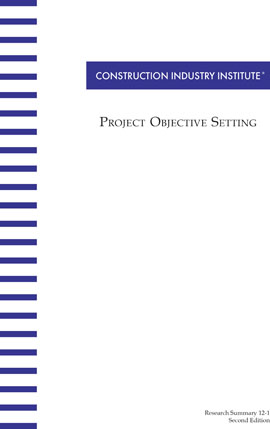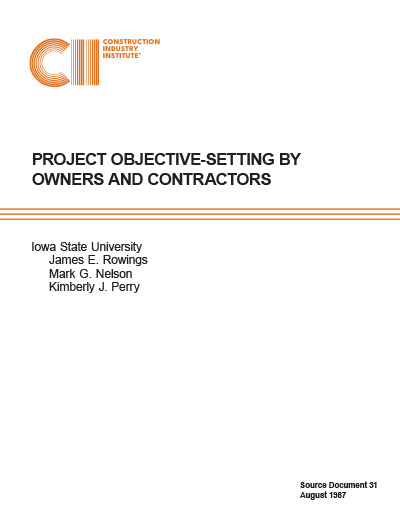
Project Objective Setting, Second Edition
All parties involved in the construction process—owners, designers, and constructors—strive for project success. A study performed by the CII Project Organization Task Force has concluded that the objective-setting process is a major determinant of this success. This publication summarizes several key areas of the study.
The first area examined is the management of objectives throughout the owner’s, designer’s, and constructor’s organizations. The management process is illustrated, and three typical problem areas impeding effective objective setting are identified. An approach for managing project objectives is then outlined and defined.
Also discussed is the process of communicating objectives between owner, designer, and constructor. Several mechanisms are discussed that promote and inhibit communication of objectives. A method for diagramming and analyzing communication channels is presented that can be used to improve objective communication and thereby improve chances for project success.
The task force developed a tool to quantify agreement between various project participants. This tool, called an Agreement Matrix, is presented and explained. A process using the matrix for managing project objectives also is explained. A correlation exists between the agreement index (calculated by using the matrix) and the assessed degree of project success for the projects examined. The Agreement Matrix is promoted as an efficient feedback device for identifying, communicating, reinforcing, and controlling project objectives. Examples of the matrix applied to actual projects are included to illustrate its use.
The process by which objectives are formulated and communicated between owner, designer, and constructor is fundamental to project success. Objectives originate from the owner’s internal organization. All of the objective setting phases are the responsibility of the owner, regardless of how many outside agencies are contracted to aid in the planning, programming, design, and construction of a project. (RS12-1, p. 1)
Three major problem areas exist in the objective-setting environment. (RS12-1, p. 3)
- Conflicting suborganization objectives
- Differing objectives within designer and contractor organizations
- Dissimilar or incompatible objectives in developing a single project strategy
Four critical elements of managing project objectives include: (RS12-1, p. 4)
- An extensive methodology for study and fact-finding
- A method to bring the various suborganizations together
- A method to convey the objectives to responsible parties
- A method to obtain feedback, provide direction or redirection, and measure agreement between parties
This research identified several key mechanisms important for effective communication of objectives, including:(RS12-1, p. 5)
- Primary mechanisms such as project execution plan, written scope of work, contract documents, and others as indicated in the publication to convey a clear, consistent set of objectives and priorities to guide the project execution.
- Reinforcing mechanisms such as incentives, correspondence, weekly meetings, executive level reinforcement, and others as indicated in the publication to provide a framework for a team-oriented approach where the objectives of the owner, designer, and constructor come together.
- In addition, the research identifies several stressing mechanisms that create situations of incompatible objectives such as poorly defined scope of work, inconsistent scope requirements, poorly designed project communication system, lack of proper expertise, a dominant external objective, and lack of project controls.
Is a tool to measure agreement between the objectives of the project participants at intermediate points in a project, and can offer insight into areas of inconsistency about objectives and priorities among the owner, designer, and constructor. It is a straightforward management tool to apply the basic principles of management by objective (MBO) to projects with multiple corporate participants. (RS12-1, p. 9)


